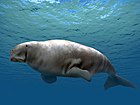Hydrodamalis
| Hydrodamalis | |
|---|---|

| |
| Skeleton of Steller's sea cow (Hydrodamalis gigas) at the Finnish Museum of Natural History | |
| Scientific classification | |
| Domain: | Eukaryota |
| Kingdom: | Animalia |
| Phylum: | Chordata |
| Class: | Mammalia |
| Order: | Sirenia |
| Family: | Dugongidae |
| Subfamily: | †Hydrodamalinae |
| Genus: | †Hydrodamalis Retzius, 1794 |
| Type species | |
| †Hydrodamalis stelleri Retzius, 1794
| |
| Species | |
|
† † †? | |
| Synonyms[1] | |
|
List
| |
Hydrodamalis is a genus of extinct
Cuesta by Daryl Domning,[5] and Takikawa by Hitoshi Furusawa.[2] The Steller's sea cow was the only member of the genus to survive into modern times, and, although had formerly been abundant throughout the North Pacific, by the mid 1700s, its range had been limited to a single, isolated population surrounding the uninhabited Commander Islands. It was hunted for its meat, skin, and fat by fur traders, and was also hunted by aboriginals of the North Pacific coast, leading to its and the genus' extinction 27 years after discovery.[6] The Cuesta sea cow along with the Takikawa sea cow were probably extinct at the end of the Pliocene due to the onset of the Ice Ages and the subsequent recession of seagrasses—their main food source.[5]
| Sirenia |
| |||||||||||||||||||||||||||||||||||||||||||||||||||||||||||||||||||||||||||
Cladogram on the relations of the hydrodamalines based on a 2004 study by Hitoshi Furuwasha [7]
References
- ^ a b "Hydrodamalis". Fossilwork.org. Retrieved 17 December 2021.
- ^ a b Furusawa, H. (1988). A new species of hydrodamaline Sirenia from Hokkaido, Japan. Takikawa Museum of Art and Natural History. pp. 1–73.
- ISBN 978-0-521-88828-8.
- ISBN 978-1-295-08525-5.
- ^ S2CID 88362556.
- JSTOR 23049853.
- .

